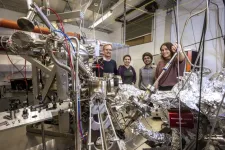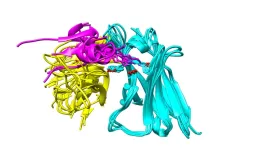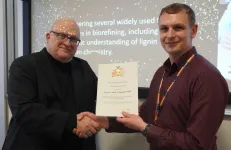(Press-News.org) Developed at Harvard, and successfully tested at Graz University of Technology (TU Graz), a revolutionary new meta-optics for microscopes with extremely high spatial and temporal resolution has proven its functional ability in laboratory tests at the Institute of Experimental Physics at TU Graz. Microscopes using this kind of lens promise completely new research and development approaches, especially in semiconductor and solar cell technology. The research team from Graz and Boston currently reports on the construction and the successful laboratory experiment with this new meta-optics in the specialist journal Science.
The lens of the microscope has made it possible to use extreme ultraviolet radiation for the first time. Its extremely short wavelength enables it to follow ultra-fast physical processes in the attosecond range. For example, real-time images from the inside of modern transistors or the interaction of molecules and atoms with light. Marcus Ossiander came up with the idea for the novel lens during his research work in Federico Capasso’s group at Harvard University, and since January 2023, the ERC Starting Grant and FWF START Award winner has been conducting research at the Institute of Experimental Physics at TU Graz.
Joint success for Boston and Graz
Attosecond physics uses extreme ultraviolet light. Because this light oscillates quickly and all the materials in the construction kit of optics development are opaque to this light, there have been no usable imaging systems for it until now. Marcus Ossiander: “I asked myself whether the classical principle of optics could not be reversed. Can you use the absence of material in small areas as the basis of an optical element?”
The lens developed at Harvard on the basis of this idea and successfully tested at TU Graz implements this design principle. A precisely calculated arrangement of tiny holes in an extremely thin silicon foil conducts and focuses the incident attosecond light. A remarkable observation of the research team is that these vacuum tunnels transmit more light energy than should be possible due to the hole-covered surface. This means that the innovative meta-optics literally sucks the ultraviolet light into the focal point.
Holes of a few nanometres in diameter
Extremely small and precisely controlled structures are required for this breakthrough. Their production is close to the limits of what is technically feasible today. The technical implementation was achieved by Federico Capasso’s team at Harvard, which is the world leader in this field, after an experimental phase of around two years. Proof of functionality was achieved in collaboration with TU Graz, where Martin Schultze’s group at the Institute of Experimental Physics is dedicated to the generation and application of ultra-short ultraviolet light flashes. “This is a great success for the cooperation between Boston and Graz. Now we want to use it to study microelectronics, nanoparticles and similar things soon,” explains Marcus Ossiander.
The meta-optics consists of an approximately 200-nanometre-thin film into which tiny hole structures have been etched. The entire lens consists of many hundreds of millions of holes; there are about ten of these structures per micrometre on the membrane. A single hole measures between 20 and 80 nanometres in diameter. For comparison: a human hair is about 60 to 100 micrometres thick, a small virus has a diameter of 15 nanometres. The diameters of the holes vary and decrease from the centre of the membrane outwards. Depending on the size of the hole, the incident light radiation there is delayed and thus collapses into a tiny focal point.
Laser meets gas cloud
To measure the new type of lens, Martin Schultze and Hana Hampel from the Institute of Experimental Physics at TU Graz have unique expertise in generating the necessary extreme ultraviolet radiation. “Reliably generating short light pulses with high energy requires precise control of light-controlled atomic processes and very precise optical set-ups. For this project, we have developed a light source that is particularly efficient in generating radiation of the wavelength for which these meta-optics were designed,” says Martin Schultze. In the experimental set-up in Graz, where a laser was focused into an inert gas jet, the extreme ultraviolet radiation could be generated and concentrated in very short pulses. The effectiveness of the meta-optics was proved by means of this light source which was optimised for attosecond physics.
Next step: a microscope with meta-optics
The development of a microscope that works with this lens is now the next step. Marcus Ossiander received his ERC Starting Grant for this advanced research work and the investigation of light-absorbing nanoparticles. After Birgitta Schultze-Bernhardt’s award in 2020, this is the second of these top-class research prizes to be picked up at the Institute of Experimental Physics at TU Graz within a short time. The possible applications for the new research field of attosecond microscopy are manifold. Semiconductor and solar cell technology in particular will benefit from the possibility of being able to track the ultrafast movement of charge carriers in space and time for the first time. In modern transistors and optoelectronic circuits, the relevant processes take place within a few nanometres of spatial expansion and in a time frame of a few attoseconds. The new meta-optics will make it possible to watch these central components of information technology at work and optimise them even further.
END
Ultra-fast light at the end of the vacuum tunnel: Meta-optics shows physical processes in the attosecond range
A new type of meta-optics from Harvard has proven its functionality in experiments at Graz University of Technology. With it, it is possible to observe the smallest structures such as nanoparticles or transistors.
2023-04-06
ELSE PRESS RELEASES FROM THIS DATE:
New atomic-scale understanding of catalysis could unlock massive energy savings
2023-04-06
MADISON – In an advance they consider a breakthrough in computational chemistry research, University of Wisconsin–Madison chemical engineers have developed model of how catalytic reactions work at the atomic scale. This understanding could allow engineers and chemists to develop more efficient catalysts and tune industrial processes — potentially with enormous energy savings, given that 90% of the products we encounter in our lives are produced, at least partially, via catalysis.
Catalyst materials accelerate chemical reactions without undergoing changes themselves. ...
Researchers reveal why viruses like SARS-CoV-2 can reinfect hosts, evade the immune response
2023-04-06
The human body is capable of creating a vast, diverse repertoire of antibodies—the Y-shaped sniffer dogs of the immune system that can find and flag foreign invaders. Despite our ability to create a range of antibodies to target viruses, humans create antibodies that target the same viral regions again and again, according to a new study led by investigators from Brigham and Women’s Hospital, a founding member of the Mass General Brigham healthcare system, and Harvard Medical School. These “public epitopes” mean that the generation ...
UH study finds Black Lives Matter movement had significant impact on Black entrepreneurs’ crowdfunding efforts
2023-04-06
New research conducted by the University of Houston Conrad N. Hilton College of Global Hospitality Leadership suggests the Black Lives Matter movement had a significant, positive impact on the fundraising efforts of Black restaurateurs.
In a study published in the International Journal of Hospitality Management, the researchers found in the decade before Black Lives Matter rose to prominence, Black restaurateurs were 76% less likely to be successful in the use of crowdfunding sources, such as Kickstarter, than non-Black restaurateurs. From 2010 – 2015, funding was 72% lower for Black-owned businesses and from 2016-2020 it was 79% lower.
But that all changed ...
Aston University hosts Royal Society of Chemistry prize-giving
2023-04-06
Professor Arthur Ragauskas awarded Royal Society of Chemistry prize
He is based at the Oak Ridge National Laboratory and University of Tennessee
He chose to receive award at Aston University because of its research into renewable resources.
Aston University has hosted a prestigious Royal Society of Chemistry prize-giving and lecture.
Professor Arthur Ragauskas of the Oak Ridge National Laboratory and University of Tennessee chose the University as the venue for this event because its research into renewable resources has inspired his work.
He is the recipient of the Society’s 2022 environment, sustainability and energy division open award: Environment ...
New professor to boost Aston University’s photonics expertise
2023-04-06
Professor Richard Hogg will be joining Aston Institute of Photonics Technologies
It is a leading photonics research centre, with a successful track record of scientific achievements
Professor Hogg will be focusing on research and commercialisation.
Aston University is to welcome Professor Richard Hogg who will be joining its flagship photonics research institute
He will be focusing on research and commercialisation at Aston Institute for Photonic Technologies, Aston University’s Aston Institute of Photonics Technologies (AIPT) a leading photonics research institute with a successful track record of ...
NASA, Webb Telescope industry team awarded Collier Trophy
2023-04-06
NASA and the James Webb Space Telescope industry team, led by Northrop Grumman Corporation, have won the prestigious National Aeronautic Association (NAA) Robert J. Collier Trophy for revolutionizing the field of astrophysics with the team’s pioneering design and exceptional performance of the telescope. The Collier Trophy is awarded annually for “the greatest achievement in aerospace and astronautics in America.” The award will be presented at the NAA Gala in Washington, D.C., on June 15.
“The James Webb Space ...
Paris will host the 6th World Congress on Targeting Phage Therapy 2023 next June with more than 51 scientific communications from 27 different countries
2023-04-06
More than 125 international academics and industrials from 27 different countries will be joining Targeting Phage Therapy 2023 on June 1-2 in Paris. During Targeting Phage Therapy 2023, 50+ communications will be presented in the form of major talks, short orals, and posters.
Among the speakers
Targeting Phages 2023 will address how phages play a strategic role to combat infection and antibiotic resistance, but also to modulate gut microbiota. Phage enthusiasts and experts will be presenting their latest data and innovations.
Domenico Frezza, University of Roma Tor Vergata, Italy
“Phage Therapy: Vision, Gaps and Evolution”
Martha Clokie, ...
Sierra squirrels find their niche amid a changing climate
2023-04-06
As the climate changes, many species are expected to adjust where and how they live. Some are expected to seek cooler elevations as it warms, but what happens to species already at the top of a mountain? A study of squirrels living in California’s high-elevation Sierra Nevada indicates that climate is only one factor to consider when trying to predict where an animal will make its home in a changing world.
The study, led by the University of California, Davis, is published in the journal Ecology and Evolution and was conducted in alpine regions stretching ...
Gender and energy key to sustainable development goals
2023-04-06
DURHAM, N.C. – Most of us woke up this morning, used energy and technology to learn about the weather and the news, got a fresh cup of coffee, and went about our day informed and refreshed.
Imagine if every woman in a poor village in rural Africa or Asia could power on technology for vital information the same way. Yet, they cannot. Lack of energy access disempowers women.
Research demonstrates that empowered people are far more resilient to climate shocks and harms. While energy technology can advance resilience, it can also create new vulnerabilities. Think of disasters that can damage complex energy systems or destroy off-grid solar home systems.
A new review published in Nature ...
Black, Hispanic severe allergy patients less likely to receive allergy shots
2023-04-06
HERSHEY, Pa. — Black and Hispanic patients with severe allergies are less likely to get a common treatment, allergen immunotherapy, compared to white patients, according to Penn State College of Medicine researchers. They said identifying the causes, which could include being less likely than white patients to be referred to an allergist and the difficulty accessing treatment due to time and other resource constraints, and developing solutions for this health disparity, could help patients get relief from symptoms, including runny nose, congestion, post-nasal drip, sinus pain and ...
LAST 30 PRESS RELEASES:
Sleeping in on weekends may help boost teens’ mental health
Study: Teens use cellphones for an hour a day at school
After more than two years of war, Palestinian children are hungry, denied education and “like the living dead”
The untold story of life with Prader-Willi syndrome - according to the siblings who live it
How the parasite that ‘gave up sex’ found more hosts – and why its victory won’t last
When is it time to jump? The boiling frog problem of AI use in physics education
Twitter data reveals partisan divide in understanding why pollen season's getting worse
AI is quick but risky for updating old software
Revolutionizing biosecurity: new multi-omics framework to transform invasive species management
From ancient herb to modern medicine: new review unveils the multi-targeted healing potential of Borago officinalis
Building a global scientific community: Biological Diversity Journal announces dual recruitment of Editorial Board and Youth Editorial Board members
Microbes that break down antibiotics help protect ecosystems under drug pollution
Smart biochar that remembers pollutants offers a new way to clean water and recycle biomass
Rice genes matter more than domestication in shaping plant microbiomes
Ticking time bomb: Some farmers report as many as 70 tick encounters over a 6-month period
Turning garden and crop waste into plastics
Scientists discover ‘platypus galaxies’ in the early universe
Seeing thyroid cancer in a new light: when AI meets label-free imaging in the operating room
Neutrophil-to-lymphocyte ratio may aid risk stratification in depressive disorder
2026 Seismological Society of America Annual Meeting
AI-powered ECG analysis offers promising path for early detection of chronic obstructive pulmonary disease, says Mount Sinai researchers
GIMM uncovers flaws in lab-grown heart cells and paves the way for improved treatments
Cracking the evolutionary code of sleep
Medications could help the aging brain cope with surgery, memory impairment
Back pain linked to worse sleep years later in men over 65, according to study
CDC urges ‘shared decision-making’ on some childhood vaccines; many unclear about what that means
New research finds that an ‘equal treatment’ approach to economic opportunity advertising can backfire
Researchers create shape-shifting, self-navigating microparticles
Science army mobilizes to map US soil microbiome
Researchers develop new tools to turn grain crops into biosensors
[Press-News.org] Ultra-fast light at the end of the vacuum tunnel: Meta-optics shows physical processes in the attosecond rangeA new type of meta-optics from Harvard has proven its functionality in experiments at Graz University of Technology. With it, it is possible to observe the smallest structures such as nanoparticles or transistors.








